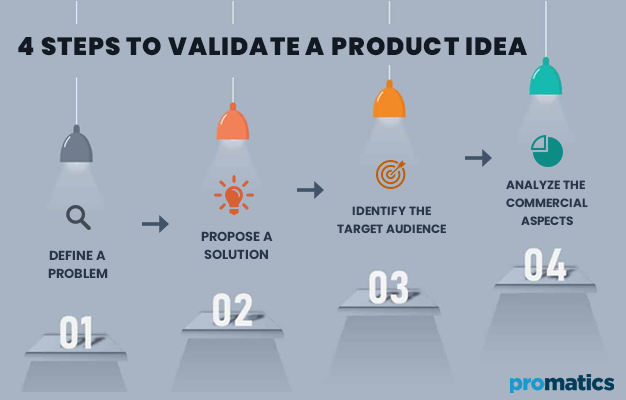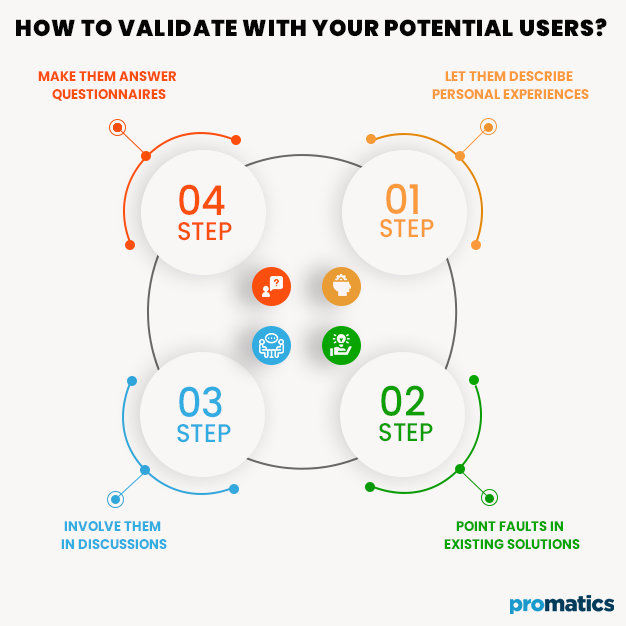Full Guide: How to Validate your Product Idea?
Entrepreneurs love to play with ideas and bring something new to the table; something new and revolutionary that solves an important problem. These people are on a quest to make life better by making technological breakthroughs. This very same innovation powered by the pursuit of improving man’s lifestyle made Apple the most valuable tech company that it is today.
Why do you need to validate your product idea?
The aspect of solving a problem is what differentiates any other businessman and an entrepreneur. If all entrepreneurs are providing innovative solutions, why do 90% of startups fail? They are trying to do something good and make money from it, it seems to be a very viable business because when a person is facing a problem, he is willing to pay premium amounts for it.
Imagine there is a voice-operated drawer that obeys your command. You would still need to reach out to pick things from inside the drawer. Just that now you might have to waste an extra 10 seconds for the drawer to come out and then you can get your stuff. Was this product a problem-solver? If you ask the entrepreneur behind it, he/she would surely say ‘Yes’. It saves time, makes your desk feel luxurious and comfortable. But in reality, it is very likely to fail because it solves a problem that people did not even know they had. Perhaps all of us do not mind opening our drawers by pulling them out in something like 1 second, pick up what we need, and be done with it in 5 seconds.
We just performed a product validation that allowed us to decide whether our idea of making money for voice-operated drawers is going to work or not. Quite simple, right?
Then why do 90% of startups fail and 42% of them for the sole reason that their product did not have a demand in the market. Unfortunately, these 42% of the lot learned things the hard way after wasting thousands of dollars of funding and tens of weeks full of efforts to make things work.
Had they validated their product idea before they even started to explore the possibilities, things would have been very different.
What exactly is Product Validation?
Product validation is the process of testing your product idea at multiple scales to determine the viability of the idea, the potential customer base that is impatient to buy your product, and how much profit can you make by selling the product.
During this process, the following three aspects are given special consideration:
a.) The nature of the problem that the product promises to solve
b.) The potential audience who are facing the issue
c.) The amount of money these people are willing to pay to get rid of the issue
This product idea (in)validation process seems simple and one might argue that the entrepreneur is doing it to make money. How can he/she ignore such important aspects?
Mistakes that Entrepreneurs make
Every entrepreneur is sure to perform the feasibility of their idea and then take decisions regarding the development strategy of the product and their company. But they often skip the very important idea validation exercise. This can be because of the following reasons:
i.) Entrepreneurs are highly intelligent individuals who are smarter than others and they know it. This idea about themselves can induce a mindset of overconfidence that what I am doing is right.’ It is under the influence of this self-recognition that they often neglect the facts and end up at a loss.
ii.) At times, entrepreneurs are not as close to their potential customers as they should be. This distance leads to a gap in the innovator’s understanding of the customer’s need and they end up making and selling stuff that no one needs.
iii.) There can be a group of like-minded individuals such as some 3 college friends who thought of doing something innovative. They end up doing some innovation but with no practical value.
All of these situations point towards ignorance about the market value and demand for the product. A product should fit the desired market. Whether it is due to my self-conception or communication gap with the customer or absence of a fresh and varying opinion, I am prone to failure because I am not performing the SWOT Analysis properly.
SWOT analysis is a technique used in management studies that aim to identify the following before a business decision is made:
S – Strengths
W – Weaknesses
O – Opportunities
T – Threats
What is the right approach?
Now that we have established that every entrepreneur needs to perform validation or an attempt of invalidation of his product idea, let’s talk about the approach that you should use while working on your project.
Audience to ask
The foremost important thing in the idea (in)validation testing is the audience whose problem you are trying to solve. It is very important to understand the thought process of this audience and the pain points in their tasks that you aim to remove.
The importance of its customer for a company can never be emphasized enough and when it comes to software products, it has become a separate area of specialization. User experience engineers learn about the user behavior, their likes, and dislikes and advise companies to modify their product to improve the user’s satisfaction.
It might be beneficial that you sit down with a UX engineer and ask him/her about the audience. Having expert advice on the appropriate audience can help you identify aspects that you as an entrepreneur might miss out on.
By no means should you ask your acquaintances about their views on the idea? Friends and family are always supportive and although this support is vital to move through life, it might become a problem and cloud your judgment on whether you should proceed with a specific product idea or not.
Remember we are not looking for confirmation, we are looking for validation. So, figure out your exact audience and sit down with them to understand the problem.
How to ask and what to ask
Validation interviews act as a door into your audience’s minds. You really want to get this bit right in order to perform a successful product idea validation.
There are certain problems with interviews:
1.) An interview might impair the audience’s judgment about the problem, and they might either try to exaggerate it or make it seem like it’s no big deal.
2.) The audience might express certain views which they might approach as what you want to listen to and might not be willing to disagree with you.
Such a situation can result in faulty feedback and in a product validation that is not accurate and is not truly representative of the actual problem.
To avoid this, change the validation interview into a validation discussion:
1.) Keep the situation as light as possible. You do not want to intimidate the audience. So simply invite people for a cup of tea or coffee and ask about their experience with a particular situation. Keep the discussion open-ended. This will help to gather a diversity of insights, exactly what you aim for.
2.) Ask people about their most recent experience and how they ended up in it. Let them walk through their story and elaborate to you precisely where they got stuck.
For example, you are performing a product validation for a doctor’s appointment booking app. Talk to people who have to consult a doctor regularly such as a diabetic or a hypertensive patient. Ask them about how often they visit their doctor if they skip their appointments or have to wait in long queues.
Do not ask ‘would you like it if you did not have to wait for your turn.’ Ask ‘how much time can you wait before it begins to get too much.’
It is only natural for an entrepreneur to search for validation for the idea but be tactical in your approach, you do not want to impair the audience’s thought process.
Will your product compete with the workarounds?
People were putting up with problems before you decided that ‘you know what, I have got to develop an app for that. Try to understand the workarounds your audience has developed around the problem.
These workarounds might be cheaper than your product or be as simple as turning a light on. You would not want to compete with such workarounds. However, the workaround adds to the problem itself, it is a viable opportunity for you to innovate and resolve the issue.
For example, you want to create a mug that keeps your coffee warm and fresh for as long as you like, so that each and every sip from that mug feels like it’s your first. Your mug will be priced at $40 each.
What if your potential customers simply get up, go to the microwave and heat it for 30 seconds, and drink their coffee when it gets cold? Would they want to drink a coffee they made in the morning at 7 in the evening?
Peek into your interviewee’s mind and you will get the rest yourself.
The workaround part is very important because it plays a significant role in identifying the threats that your product might face, the ‘T’ in SWOT.
Humans are unpredictable
Always ask about your potential customer’s past experience. Ask them about the last couple of times they faced the problem and not a future situation. All humans have a creative brain. No one has any idea about what the person sitting right next to us might come up with in the next 5 minutes.
So, always ask about the past instances and how the person resolved the issue. Who knows, you might even get a new and better solution to a problem you were trying to solve but in a less efficient or more costly manner.
What to conclude, how to conclude?
You went through the entire product validation process. You interviewed a sufficient number of people that truly represented your target audience. It is time to decide whether to move forward with the idea or move on from the idea.
I.) If the audience is properly frustrated about the problem and is willing to pay to get rid of the issue, congratulations. Your idea has passed the validation test. You can confidently invest in the product and give your customers a sigh of relief.
II.) If you came across a mixed opinion on the problem, some people were absolutely frustrated, others a little, and some who had not faced the problem or had an excellent workaround the issue, you need to refine the audience you are trying to target or drop the idea in all.
III.) If you have a sufficient number of appropriate people and they do not find it a big deal living with the problem, congratulations once again. You just saved yourself some disappointment and your investor a bankruptcy while also not adding to the list of 42% failed startups due to lack of a problem-solving product.
In the nutshell…
Product validation might be thought of as an innovation-killer, but it is important to understand that everything does not need innovation and improvement.
And again, innovation is not everything. While designing a solution to the problem, you might get to call yourself an entrepreneur or an inventor (the really some very desirable titles) but another thing that matters is the money.
Not just that you need money to develop the idea, you need money to sustain it as well or the idea will die on its own if it ends up filing bankruptcy.
Product validation, on one hand, saves you yourself from getting into a fix while solving a fix, it also helps to bring forward ideas with the greatest potential. Once your idea has passed the validation test, you end up having greater insights into your product. This not only gives you more confidence as an entrepreneur, but you will also have an edge at the time of convincing an investor as well.
So, my fellow intellectual being, don’t be silly. Think before you do. Promatics conducts free discovery workshops for entrepreneurs to sculpt the best possible draft for their ideas. So do not rely solely on your intellect. Interview your audience, gather insights on their experiences and then decide whether you should proceed with something or not. Best of luck!
Still have your concerns?
Your concerns are legit, and we know how to deal with them. Hook us up for a discussion, no strings attached, and we will show how we can add value to your operations!


